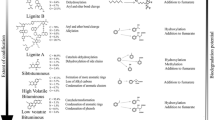Abstract
Biological conversion of low-Btu coal synthesis gas to higher Btu methane was demonstrated using both pure co-cultures and/or adapted-mixed anaerobic bacteria.Peptostreptococcus productus metabolized coal gas to mainly acetate and CO2. The co-cultures containing methanogens converted these products to methane. In mixed culture studies, CH4 and small amounts of acetate were produced. Reactor studies using stirred-tank and immobilized cell reactors exhibited excellent potential to convert CO, CO2 and H2 to methane at higher gas flow rates. Gas retention times ranging from 0.7 to 2 hours and high agitation were required for 90 percent CO conversion in these systems. This paper also illustrates the potential of biological methanation and demonstrates the need for good mass transfer in converting gas phase substrates.
Similar content being viewed by others
References
Ljungdahl, L. G., and Wiegel, J. (1986), “Working with Anaerobic Bacteria,” (Demain, A. L., Solomon, N. A., ed.), inManual of Industrial Microbiology and Biotechnology, ch. 8, pp. 84–96, ASM, Washington, DC.
Escalamte-Semerena, J. C, Rinehart, Jr., K. L., and Wolfe, R. S. (1984), “New Insights into the Biochemistry of Methanogenesis from H2 and CO2,” pp. 191 – 198, in (Crawford, R. L., and Hanson, R. S., eds.),Microbial Growth on C1 Compounds. Proc. 4th Int. Symp. Microbioh., Washington, DC.
Jones, W. J., Nagle, Jr., D. P., and Whitman, W. B. (1987), “Methanogens and the Diversity of Archaebacteria,”Microb. Rev. 51(1) 135–177.
Huser, B. A., Wuhrmann, K., and Zehnder, A. J. B. (1982),Methanothrix soehngenii nov. sp. nov., A New Acetotrophic Non-Hydrogen-Oxidizing Methane Bacterium,”Arch. Microbial.,132, 1–9.
Daniels, L., Fuchs, G., Thauer, R. K., and Zeikus, L. G. (1977), “Carbon Monoxide Oxidation by Methanogenic Bacteria,”J. Bacteriol.,132, 118–126.
Fisher, F., Leiske, R., and Winzer, K. (1981), “Umstzung in des Kohlenoxyds,”Biochem. Z.,236, 247–267.
Fisher, F., Leiske, R., and Winzer, K. (1932), “Uber die bildung von Essigsaure bei der biologischen Umsetzung von Kohlenoxyd Und Kohlensaure mit Wasserstoff zu Methan,”Biochem. Z.,245, 2–12.
Stephenson, M., and Strickland, L. H. (1933), “The Bacterial Formation of Methane by the Reduction of One-Carbon Compounds by Molecular Hydrogen,”Biochem. J., 1417 – 1527.
Kluyver, A. J., and Schnellen, C. G. (1947), “On the Fermentation of Carbon Monoxide by Pure Cultures of Methane Bacteria,”Arch. Biochem. 14, 57–70.
Uffen, R. L. (1976), “Anaerobic Growth of aRhodoseudomonas Species in the Dark With Carbon Monoxide as Sole Carbon and Energy Substrate,”Proc. Natl. Acad. Sci. USA,73, 3298–3302.
Dushekvicz, M. P. and Uffen, R. L. (1979), “Identification of a Carbon Monoxide-Metabolizing Bacterium as a Strain ofRhosospeudomonas gelatinosa,” Int. Jnl. System. Bad.,29, 145–148.
Breed, R. S., Murray, E. G. D., and Smith, N. R. (1977),Bergey’s Manual of Determinative Bacteriology, (8th ed.), Williams and Wilkins, Baltimore, MD.
Lorowitz, W. H., and Bryant, M. P. (1984), “Peptostreptococcus productus Strain that Grows Rapidly with CO as the Energy Source,”Appl. and Envir. Microbiol. 47, 961–964.
Zeikus, J. G., (1983), “Metabolism of One-Carbon Compounds by Chemotrophic Anaerobes,”Adv. in Micro. Physiol.,24, 224.
Genthner, B. R. S., and Bryant, M. P. (1983), “Growth ofEubacterium limosum with Carbon Monoxide as the Energy Source,”Appl. and Envir. Microbiol. 43, 70–74.
Smith, M. R., and Mah, R. A. (1978), “Growth and Methanogenesis byMethanosarcina Strain 227 on Acetate and Methanol,”Appl. Environ. Microbiol. 36, 870–879.
Hungate, R. E. (1950), “The Anaerobic, Mesophilic, Cellulolytic Bacteria,”Bacteriol. Rev.,14, 1–49.
Bryant, M. P. (1972), “Commentary on the Hungate Technique for Culturing Anaerobic Bacteria,”Am. J. Clin. Nutr. 25, 1324–1328.
Balch, W. E., and Wolfe, R. S. (1976), “New Approach to the Cultivation of Methanogenic Bacteria: 2-Mercaptoethane Sulfonic Acid (HS-COM)-Dependent Growth ofMethanobacterium ruminantium in a Pressurized Atmosphere,”Appl. Environ. Microbiol. 32, 781–791.
Barik, S., Vega, J. L., Johnson, E. R., Clausen, E. C, and Gaddy, J. L. (1987), “Methanation of Synthesis Gas Using Biological Processes,”Biotechnol. Appl. to Fossil Fuels, CRC Press.
Bailey, J. E., and Ollis, D. F. (1986),Biochem. Eng. Fund., 2nd ed., McGraw-Hill, NY.
Author information
Authors and Affiliations
Rights and permissions
About this article
Cite this article
Barik, S., Vega, J.L., Clausen, E.C. et al. Biological conversion of coal gas to methane. Appl Biochem Biotechnol 18, 379–392 (1988). https://doi.org/10.1007/BF02930841
Issue Date:
DOI: https://doi.org/10.1007/BF02930841




